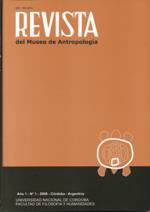How to do chicha in Cordoba? Reflections on the political and material aspects of the production of chicha by Bolivian immigrants
DOI:
https://doi.org/10.31048/1852.4826.v1.n0.5393Keywords:
gastro-politics, material culture, chicha, Bolivian immigration, CórdobaAbstract
Beverages and food might be considered as instances with a special daily routine, and with a poetic and a special gastro-politic, which implicates in the everyday reproduction and in the sense of membership in a group. In these instances different subjects and materialities convergence, which articulates in a process in which themselves are defined. From this perspective, it interests us to reflect around the «chicha» (a fermented beverage based on maize) production processes from the view of the Bolivian women immigrants and it articulation with other contexts in the city of Córdoba (Argentina). We consider that it exists a tension between the necessity to count with this beverage for certain celebrations and the difficulty to produce it, and the tension which are inscribed in the marginal situations that experience the majority of the immigrants. To approximate the gastro-politics that unfolds in these production processes, we concentrate on the trajectories of the «chichera» women, as the source materials and other necessities for its elaboration.Downloads
References
Abercrombie, T. 1993. Caminos de la memoria en un cosmos colonizado. Poética de la bebida y la conciencia histórica en K’ulta. Saignes, T. (comp.): Borrachera y memoria. La experiencia de los sagrado en los Andes, 139-170. Hisbol/IFEA, La Paz.
Appadurai, A. 1981. Gastro-politics in South Asia. American Ethnologist 8, 3:494-511.
[1995] La construcción de lo local. La modernidad desbordada. Dimensiones culturales de la globalización. Capítulo 9: 187-207. Trilce – FCE.
Arnold, D. (coord). 1998. Hacia un orden andino de las cosas. Tres pistas de los Andes meridionales. Hisbol/ILCA, Bolivia.
Bourdieu, P. 1977. Outline of a Theory of Practice. Cambridge Unversity Press, Cambridge.
Bourdieu, P. y L. Wacquant. 1995. Respuestas. Por una antropología reflexiva. Grijalbo, México.
Cutler, H. y M. Cárdenas. 1985 [1947]. Chicha, una cerveza indígena sudamericana. Lechtmann, H; Soldi, A. M. (coord.): La tecnología en el mundo andino, 247-259. UNAM, México.
Fernández Juárez, G. 1997. Entre la repugnancia y la seducción. Ofrendas complejas en los Andes del Sur. Centro de estudios regionales andinos, Perú.
Giddens, A. 1984. The Constitution of Society. Outline of the Theory of Structuration. University of California Press, Berkeley y Los Ángeles.
Hodder, I. 1990. The Domestication of Europe. Structure and Contingency in Neolithic Societies. Basil Blackwell, Oxford.
Jennings, J., K. Antrobus, S. Atencio, E. Glavich, R. Johnson, G. Loffler, y C. Luu. 2005. ‘Drinking Beer in a Blissful Mood’ Alcohol Production, Operational Chains, and Feasting in the Ancient World. Current Anthropology 46, 2:275:304.
Paredes, M. R. 1936. Mitos, supersticiones y supervivencias populares de Bolivia. Imprenta Atenea, La Paz, Bolivia.
Pazzarelli, F. y G. Vargas Ibarra. 2007. Rico es pues allá. Chicheras, recetas y objetos en un proceso de producción de chicha en Córdoba. Actas, IV Reunión Internacional de Teoría Arqueológica en América del Sur / Inter-Congreso del WAC, 180-181. Catamarca.
Randall, R. 1993. Los dos vasos. Cosmovisión y política de la embriaguez desde el incanato hasta la colonia.
Saignes, T (comp.), Borrachera y memoria. La experiencia de los sagrado en los Andes. 73:112. Hisbol/IFEA, La Paz Saignes, T. 1993. «Estar en otra cabeza»: tomar en los Andes. Saignes, T (comp.), Borrachera y memoria. La experiencia de los sagrado en los Andes. 11:21. Hisbol/IFEA, La Paz.
SENASA. 1999. Manual de procedimientos en control de personas, equipajes y vehículos de transporte en puestos de frontera. Resolución Nº 295/99. Link http//www.senasa.gov.ar. Último acceso 2/07/08.
Shanks, M. y C. Tilley. 1987. Re-constructing archaeology. Theory and practice. Cambridge University Press, Cambridge.
Rostworoski, M. 2004. Costa Peruana Prehispánica. Instituto de Estudios Peruanos, Lima.
Downloads
Published
How to Cite
Issue
Section
License
Those authors who have publications with this Journalaccept the following terms:
a. Authors will retain their copyrights and guarantee the journal the right of first publication of their work, which will be simultaneously subject to the Creative Commons Attribution License (Licencia de reconocimiento de Creative Commons) that allows third parties to share the work as long as its author and his first publication in this journal.
b. Authors may adopt other non-exclusive licensing agreements for the distribution of the version of the published work (eg, deposit it in an institutional electronic file or publish it in a monographic volume) provided that the initial publication in this journal is indicated.
c. Authors are allowed and recommended to disseminate their work on the Internet (eg in institutional telematic archives or on their website) before and during the submission process, which can lead to interesting exchanges and increase citations of the published work. (See The Effect of Open Access - El efecto del acceso abierto)












